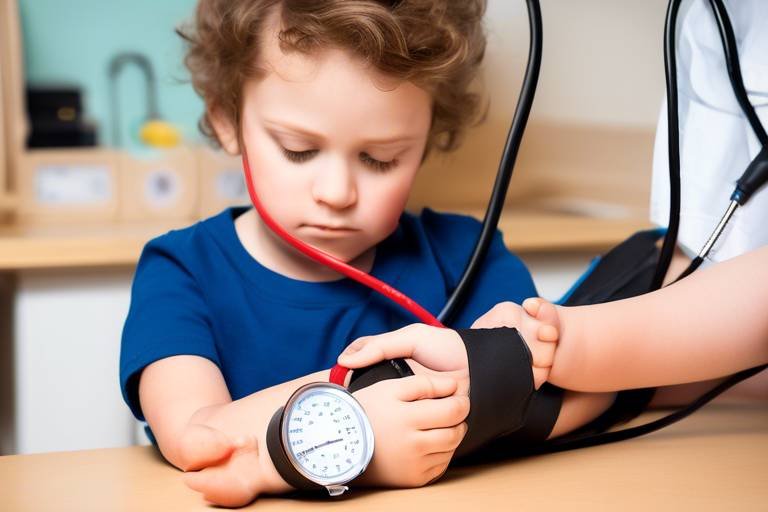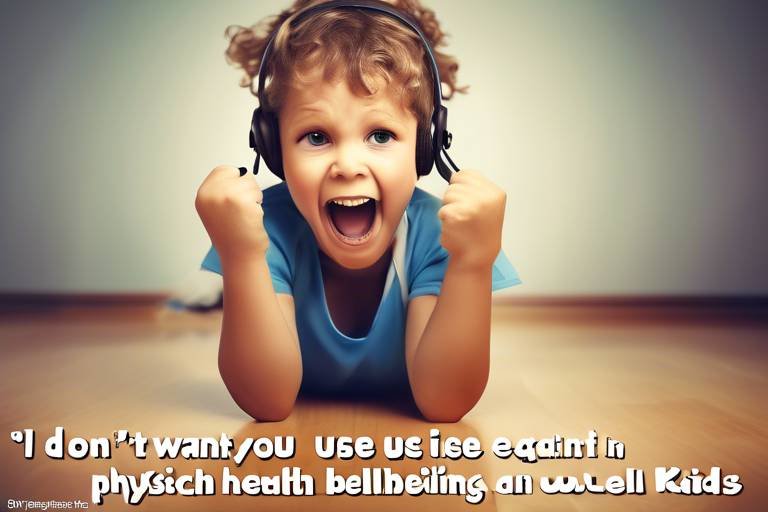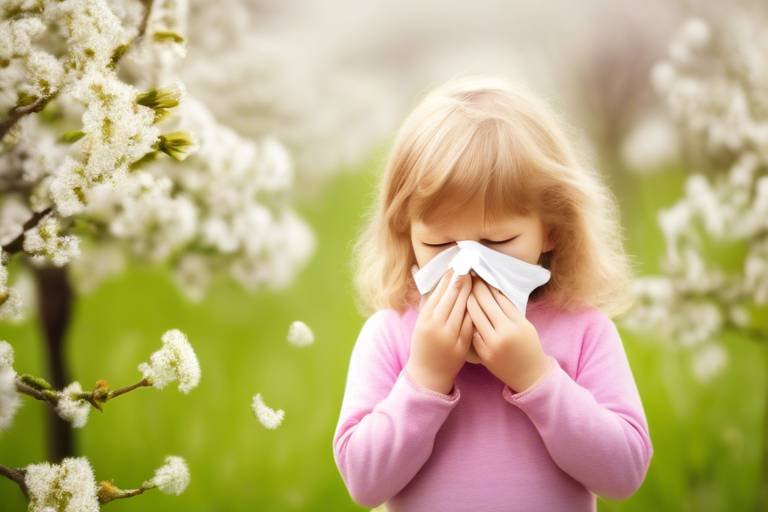The Importance of Regular Blood Pressure Checks for Kids
As parents, we often focus on our children's growth, education, and emotional well-being, but one crucial aspect that sometimes slips through the cracks is their blood pressure. You might wonder, "Why should I care about my kid's blood pressure?" Well, just like a car needs regular maintenance to run smoothly, our children's bodies require consistent check-ups to ensure they are functioning optimally. Monitoring blood pressure is not just a concern for adults; it is equally significant for kids. In fact, regular blood pressure checks can be a game-changer in identifying potential health issues before they escalate.
High blood pressure, or hypertension, is often referred to as a "silent killer" because it usually doesn't present any obvious symptoms. This makes it all the more important to keep an eye on it from a young age. By staying proactive about your child's health, you can help them lead a healthier life, free from the complications that can arise from unchecked blood pressure levels. So, let’s dive into why monitoring blood pressure is essential for kids and how you can be a vigilant guardian of their health.
Blood pressure is the force exerted by circulating blood against the walls of blood vessels. It is measured in millimeters of mercury (mmHg) and is represented by two numbers: systolic (the pressure when the heart beats) over diastolic (the pressure when the heart rests between beats). In children, blood pressure varies significantly based on age, height, and weight. This variability is why it's crucial to understand that what may be considered normal for an adult can be quite different for a child.
Monitoring blood pressure in children allows for the early detection of hypertension, which can lead to serious health issues if left untreated. Parents should be aware that childhood hypertension can be linked to lifestyle factors such as diet and physical activity, as well as genetic predispositions. The earlier you catch any irregularities, the better you can manage and mitigate potential health risks.
High blood pressure in children is not something to take lightly. It can lead to a multitude of health risks, including:
- Heart Disease: Hypertension can damage the arteries, leading to heart conditions later in life.
- Stroke: High blood pressure increases the risk of stroke as it can cause blood vessels to burst or become blocked.
- Kidney Damage: Elevated blood pressure can harm the kidneys, affecting their ability to filter waste from the blood.
- Long-term Complications: If hypertension goes unchecked, it can lead to serious issues that may endure into adulthood.
To illustrate the importance of monitoring blood pressure, consider this: a child's body is like a delicate ecosystem. Every component must work harmoniously to promote health and well-being. If one area—like blood pressure—is out of balance, it can disrupt the entire system, leading to complications that could have been avoided with regular checks.
Several factors can contribute to elevated blood pressure in children. Understanding these causes is vital for effective prevention and management. Common causes include:
- Obesity: The rising rates of childhood obesity are closely linked to increased instances of hypertension.
- Sedentary Lifestyle: Lack of physical activity can contribute to weight gain and high blood pressure.
- Genetic Factors: A family history of hypertension can increase the likelihood of a child developing high blood pressure.
Obesity is an epidemic that affects millions of children worldwide, and its correlation with high blood pressure is undeniable. When a child carries excess weight, their heart has to work harder to pump blood throughout the body, which can lead to increased blood pressure. Addressing weight management early on is crucial. Encouraging healthy eating habits and regular physical activity can substantially lower the risk of hypertension.
Family history also plays a significant role in a child's likelihood of developing high blood pressure. If parents or close relatives have hypertension, the child may be at a higher risk. This genetic predisposition underscores the importance of regular monitoring and proactive health management, even if the child appears healthy.
Recognizing the signs of high blood pressure in children can be quite challenging. Unlike adults, children often do not exhibit noticeable symptoms. However, parents should be vigilant for subtle indicators such as:
- Frequent headaches
- Nosebleeds
- Fatigue or confusion
- Difficulty sleeping
If you notice any of these symptoms, it’s essential to consult a healthcare provider for a thorough evaluation. Early intervention can make a world of difference.
So, how often should you have your child's blood pressure checked? The American Academy of Pediatrics recommends that children have their blood pressure measured at least once a year starting at age three, or more frequently if they are at risk due to obesity or family history. Regular monitoring is key to catching any potential issues early.
Here’s a quick reference table for blood pressure screening guidelines based on age:
| Age Group | Screening Frequency |
|---|---|
| 3-5 years | Yearly |
| 6-11 years | Yearly |
| 12-18 years | Yearly or more frequently if at risk |
Preparation can significantly impact the accuracy of blood pressure readings. Here are some tips for parents:
- Ensure your child is calm and relaxed before the check.
- Avoid caffeine or heavy meals an hour before the appointment.
- Encourage your child to sit quietly for a few minutes before the test.
Ultimately, the best way to maintain optimal blood pressure levels is by promoting healthy lifestyle choices. Encourage your children to eat a balanced diet rich in fruits, vegetables, whole grains, and lean proteins. Regular physical activity—aiming for at least 60 minutes a day—can also help keep their weight in check and blood pressure levels stable. Don't forget the importance of stress management, too; teaching kids to cope with stress through mindfulness or physical activity can contribute to overall health.
Q: At what age should I start monitoring my child's blood pressure?
A: It is recommended to start monitoring blood pressure at age three, with yearly checks thereafter.
Q: What should I do if my child's blood pressure is high?
A: Consult your healthcare provider for further evaluation and management options.
Q: How can I help my child maintain a healthy blood pressure?
A: Encourage a balanced diet, regular exercise, and teach stress management techniques.

Understanding Blood Pressure in Children
When we talk about blood pressure, we're essentially discussing the force of blood pushing against the walls of the arteries as the heart pumps it around the body. It’s a critical indicator of health, but did you know that blood pressure in children isn't the same as in adults? That's right! In fact, children's blood pressure levels are influenced by their age, height, and even gender. This means that what might be considered high for an adult could be perfectly normal for a child.
Monitoring blood pressure in children is crucial for early detection of potential health issues. Think of it like a smoke detector in your home; it might not be needed every day, but when it goes off, it’s a signal that something needs attention. Just as you wouldn’t ignore a smoke alarm, you shouldn’t overlook the importance of regular blood pressure checks for your kids. High blood pressure, or hypertension, can sneak up on children without any obvious symptoms, making routine checks even more vital.
So, why is it essential to keep an eye on these numbers? Well, early detection can lead to early intervention. If a child is found to have high blood pressure, parents can work with healthcare providers to identify the underlying causes and implement necessary lifestyle changes. This proactive approach can help prevent long-term health complications that may arise later in life, such as heart disease or stroke.
It’s also important to note that the methods for measuring blood pressure in children differ slightly from adults. Healthcare professionals use special blood pressure cuffs that are appropriately sized for children, ensuring accurate readings. If you're ever curious about your child's blood pressure reading, don't hesitate to ask your healthcare provider about what those numbers mean and how they compare to standard pediatric ranges.
In summary, understanding blood pressure in children is not just about knowing what the numbers are; it's about recognizing the significance of those numbers in the context of your child’s overall health. By staying informed and vigilant, you can help pave the way for a healthier future for your little ones.

Health Risks of High Blood Pressure
High blood pressure, or hypertension, is often dubbed the "silent killer" because it typically shows no symptoms until it’s too late. For children, the implications of elevated blood pressure can be particularly alarming. While we often associate hypertension with adults, more and more kids are experiencing this condition, which can lead to serious health risks if not addressed early on. Imagine a ticking time bomb; it may seem harmless at first, but without intervention, it can lead to catastrophic results.
The health risks associated with high blood pressure in children can be severe and long-lasting. One of the most significant concerns is the increased risk of developing heart disease. Hypertension forces the heart to work harder than normal, which can lead to structural changes in the heart over time. This might not show immediate effects, but as the child grows into adulthood, they could face serious cardiovascular issues. According to studies, children with high blood pressure are more likely to have elevated cholesterol levels and other risk factors that contribute to heart disease.
Another alarming risk is the possibility of stroke. While it may sound far-fetched for a child to experience a stroke, the reality is that hypertension can damage blood vessels and increase the likelihood of clots forming. These clots can travel to the brain, leading to a stroke, which can have devastating consequences. It’s essential for parents to understand that the earlier hypertension is detected, the better the chance of preventing these serious outcomes.
In addition to heart disease and stroke, high blood pressure can lead to other long-term complications, such as:
- Kidney damage: The kidneys play a crucial role in regulating blood pressure. High blood pressure can damage the blood vessels in the kidneys, leading to chronic kidney disease.
- Vision problems: Hypertension can damage the blood vessels in the eyes, potentially leading to vision impairment or even blindness.
- Metabolic syndrome: This cluster of conditions, including increased blood pressure, high blood sugar, excess body fat around the waist, and abnormal cholesterol levels, raises the risk of heart disease, stroke, and diabetes.
It’s clear that the ramifications of high blood pressure in children extend far beyond just immediate health concerns. The long-term impact can be life-altering, affecting not only their physical health but also their quality of life. This is why regular monitoring and early intervention are so crucial. Parents should be proactive in discussing blood pressure checks with their pediatricians and understanding the importance of maintaining healthy blood pressure levels from a young age.
In conclusion, the health risks associated with high blood pressure in children are significant and multifaceted. It's not just about the numbers on a chart; it's about the overall well-being of our kids. By raising awareness and taking preventive measures, we can help ensure that our children lead healthy, vibrant lives free from the shadow of hypertension.
Q: At what age should I start monitoring my child's blood pressure?
A: It’s recommended to start monitoring blood pressure at age 3 during routine check-ups, especially if there are risk factors present.
Q: What can I do to help my child maintain healthy blood pressure?
A: Encourage a balanced diet rich in fruits, vegetables, and whole grains, promote regular physical activity, and limit screen time and sugary drinks.
Q: Are there any symptoms of high blood pressure in children?
A: High blood pressure often has no symptoms, which is why regular monitoring is essential. However, if a child complains of headaches, dizziness, or nosebleeds, it could be a sign to check their blood pressure.

Causes of High Blood Pressure in Kids
When we think about high blood pressure, we often picture it as a condition that affects adults, but the reality is quite different. High blood pressure, or hypertension, can also affect children, and understanding the causes behind this condition is crucial for parents. So, what exactly contributes to elevated blood pressure levels in our little ones? Let's break it down.
One of the most significant factors leading to high blood pressure in children is obesity. As children lead increasingly sedentary lifestyles, often glued to screens or engaged in less physical activity, their weight can spiral out of control. This excess weight puts a strain on the heart and can lead to hypertension. Studies have shown that children with obesity are at a much higher risk of developing high blood pressure, making it imperative for parents to monitor their child's weight and encourage regular physical activity.
Additionally, genetic factors can play a substantial role in a child's blood pressure levels. If there's a family history of hypertension, children may inherit this predisposition. It's like a ticking time bomb; if hypertension runs in the family, children may be at risk even if they appear healthy. Therefore, being aware of family medical history can help parents take proactive measures.
Moreover, a poor diet can significantly contribute to high blood pressure. Diets high in sodium, saturated fats, and processed foods can lead to weight gain and increase blood pressure. Parents should encourage a balanced diet rich in fruits, vegetables, whole grains, and lean proteins. It's essential to teach children about healthy eating habits early on, as these choices often follow them into adulthood.
Another contributing factor is a lack of physical activity. In today's fast-paced world, children often miss out on the benefits of regular exercise. Engaging in physical activities not only helps maintain a healthy weight but also strengthens the heart and improves overall cardiovascular health. Parents should strive to make exercise a fun part of their children's daily routine, whether it's through sports, dancing, or simply playing outside.
Lastly, stress can be an overlooked cause of high blood pressure in children. Just like adults, kids can experience stress from school, social pressures, or family issues. Chronic stress can lead to unhealthy coping mechanisms, such as overeating or a lack of exercise, further exacerbating the problem. Encouraging mindfulness, open communication, and healthy coping strategies can help mitigate stress levels in children.
In summary, the causes of high blood pressure in kids are multifaceted, including obesity, genetic predisposition, poor diet, lack of physical activity, and stress. By understanding these factors, parents can take proactive steps to help their children maintain healthy blood pressure levels and promote a healthier lifestyle.
- What age should my child start having their blood pressure checked? It is recommended that children have their blood pressure checked starting at age 3 during routine check-ups.
- How can I help my child maintain a healthy weight? Encourage regular physical activity, provide healthy food options, and limit screen time to promote a more active lifestyle.
- What are the signs of high blood pressure in children? Some signs may include headaches, dizziness, or blurred vision. However, many children may not show any symptoms, which is why regular monitoring is important.

Obesity and Its Impact
Obesity is more than just a buzzword; it's a growing epidemic that has serious implications for the health of our children. When we talk about obesity, we're referring to a condition where a child's body weight is significantly higher than what is considered normal for their age and height. This excess weight can lead to a myriad of health issues, one of the most concerning being high blood pressure. But why is this connection so strong?
First off, let's consider the mechanics. Excess body fat can lead to increased resistance in the blood vessels, making the heart work harder to pump blood throughout the body. This added strain can elevate blood pressure levels, often leading to hypertension. In fact, studies have shown that children who are classified as obese are at a much higher risk of developing high blood pressure compared to their peers with a healthy weight. The correlation is alarming and highlights the need for proactive measures.
Imagine your child's body as a well-tuned engine; every part needs to work harmoniously for optimal performance. When obesity enters the picture, it's as if someone has added extra weight to that engine, causing it to sputter and struggle. This can lead to not just hypertension, but also other serious conditions such as type 2 diabetes, heart disease, and even psychological issues like anxiety and depression. The impact of obesity is far-reaching, affecting both physical and mental health.
Furthermore, the alarming rise in childhood obesity can often be attributed to lifestyle choices and environmental factors. Many children today lead a sedentary lifestyle, spending hours glued to screens instead of engaging in physical activity. Coupled with poor dietary choices—think fast food, sugary drinks, and snacks—it's no wonder obesity rates are climbing. To put this in perspective, consider the following statistics:
| Year | Percentage of Obese Children |
|---|---|
| 1990 | 6.1% |
| 2000 | 15.3% |
| 2010 | 19.6% |
| 2020 | 22.4% |
As you can see, the trend is worrying. The earlier we address these issues, the better chance we have at reversing the tide. Parents play a crucial role in this by promoting healthy eating habits and encouraging physical activity. Small changes, like opting for fruits and vegetables over processed snacks, can make a significant difference. Moreover, involving children in meal planning and cooking can foster a sense of responsibility and awareness about their dietary choices.
In summary, obesity is a critical factor that can lead to high blood pressure in children. It’s essential for parents to be vigilant and proactive, ensuring their kids lead a healthy lifestyle. By tackling obesity head-on, we can help our children avoid the pitfalls of hypertension and set them on a path toward a healthier future.
- What is considered obese for children? Obesity in children is typically determined using the Body Mass Index (BMI) which takes into account their age, height, and weight. A BMI at or above the 95th percentile is considered obese.
- How can I help my child maintain a healthy weight? Encourage regular physical activity, limit screen time, and promote a balanced diet rich in fruits, vegetables, and whole grains.
- What are the long-term effects of childhood obesity? Childhood obesity can lead to serious health issues in adulthood, including heart disease, diabetes, and certain cancers.
- When should I be concerned about my child's blood pressure? Regular check-ups can help monitor blood pressure. If your child shows signs of hypertension or has a family history of heart disease, consult a healthcare professional.

Genetic Factors
When it comes to understanding high blood pressure in children, one cannot overlook the significant role of genetics. Just like how a child may inherit their eye color or height from their parents, blood pressure levels can also be influenced by family history. If parents or close relatives have a history of hypertension, there’s a higher chance that their children may develop similar issues. This genetic predisposition can act as a silent influencer, often unnoticed until health complications arise.
It’s fascinating to think of genetics as a double-edged sword. On one hand, it can confer certain risks, while on the other, it can also offer resilience against certain conditions. For instance, if a child has parents who maintain a healthy lifestyle, they may inherit not only the genetic predisposition but also the habits that help manage their blood pressure effectively. This interplay between genetics and lifestyle choices is crucial, making it essential for parents to be aware of their family health history.
Moreover, the genetic factors affecting blood pressure are not limited to just one or two genes. Instead, they involve a complex interaction of multiple genes, which can affect various physiological processes, such as:
- Salt Sensitivity: Some children may have genes that make them more sensitive to salt, leading to higher blood pressure levels.
- Kidney Function: Genetic variations can influence how well the kidneys regulate blood pressure.
- Hormonal Regulation: Certain genetic traits can affect the body’s hormonal response, which is crucial in blood pressure control.
Understanding these genetic factors can empower parents to take proactive measures in monitoring and managing their children's health. Regular check-ups and open discussions with healthcare providers can help in identifying potential risks early on. By doing so, parents can implement lifestyle changes that may mitigate the impact of genetic predispositions, ensuring that their children lead healthier lives.
Q: Can high blood pressure in children be hereditary?
A: Yes, if there is a family history of hypertension, children may be at a greater risk of developing high blood pressure themselves.
Q: What lifestyle changes can help manage genetic predispositions to hypertension?
A: Encouraging a balanced diet, regular physical activity, and maintaining a healthy weight can significantly help in managing blood pressure levels.
Q: How often should my child have their blood pressure checked?
A: It is advisable for children to have their blood pressure checked during regular health visits, with more frequent checks if there are risk factors present.

Signs and Symptoms of Hypertension
Recognizing the signs and symptoms of hypertension in children can be a bit like searching for a needle in a haystack. Often, high blood pressure is dubbed the "silent killer" because it sneaks up without any noticeable symptoms. This makes it crucial for parents to be vigilant and proactive. While adults might experience headaches, dizziness, or nosebleeds, children may not show these classic signs. Instead, the symptoms can be subtle and easily overlooked, which is why regular monitoring is essential.
Some children might exhibit a few telltale signs that could indicate elevated blood pressure. For instance, if you notice your child frequently complaining of headaches or feeling unusually fatigued after activities they normally enjoy, it might be time to consult a healthcare professional. Other potential symptoms can include:
- Chest pain: If your child mentions discomfort in their chest, this is a red flag that should not be ignored.
- Shortness of breath: Difficulty breathing, especially during physical activity, can indicate underlying health issues.
- Vision problems: Blurred or impaired vision may occur, which can be alarming for both the child and the parents.
It's important to understand that these symptoms are not exclusive to hypertension and can stem from various other health conditions. Therefore, if you notice any of these signs, it’s vital to seek medical advice. Regular check-ups with a pediatrician can help catch any potential issues before they escalate into serious health problems.
Furthermore, some children might not show any symptoms at all, which is why routine blood pressure checks are so important. The American Academy of Pediatrics recommends that children have their blood pressure measured at least once a year starting at the age of three. This proactive approach can help identify hypertension early, allowing for timely intervention and lifestyle adjustments.
In conclusion, being aware of the signs and symptoms of hypertension in children is a crucial step in safeguarding their health. Remember, early detection can make all the difference, so don’t hesitate to schedule regular check-ups and monitor your child’s blood pressure as they grow.
- Q: At what age should my child start having their blood pressure checked?
A: The American Academy of Pediatrics recommends starting blood pressure checks at age three during regular check-ups. - Q: What should I do if my child's blood pressure readings are high?
A: Consult with your pediatrician for further evaluation and to discuss potential lifestyle changes or treatments. - Q: Are there lifestyle changes that can help lower my child's blood pressure?
A: Yes, encouraging a balanced diet, regular physical activity, and stress management can significantly help in maintaining healthy blood pressure levels.

Guidelines for Regular Monitoring
When it comes to monitoring your child's blood pressure, consistency is key. Just like you wouldn't skip your own annual check-up, your child deserves the same level of attention. The American Academy of Pediatrics recommends that children have their blood pressure checked at least once a year during their routine health exams. However, if your child has risk factors such as obesity, a family history of hypertension, or other health concerns, more frequent monitoring may be necessary.
But how do you know what’s right for your child? It’s essential to consult with your pediatrician to create a personalized monitoring plan. They can provide specific recommendations based on your child's health status and growth patterns. Remember, blood pressure can fluctuate, so it’s crucial to monitor it regularly to catch any concerning trends early.
In addition to annual check-ups, parents can also consider home monitoring as a useful tool. Many pharmacies sell blood pressure monitors that are easy to use and provide accurate readings. Here are some tips for effective home monitoring:
- Choose the right cuff size: Make sure the cuff fits snugly around your child's arm, as an incorrect size can lead to inaccurate readings.
- Take multiple readings: For the best results, take two or three readings at the same time of day, and average them for a more accurate picture.
- Keep a record: Document your child's readings over time to identify any patterns or concerns that you can discuss with your healthcare provider.
Furthermore, understanding the age-specific recommendations for blood pressure screenings is crucial. For instance, children aged 3 years and older should have their blood pressure checked at least annually. The table below summarizes the recommended frequency based on age:
| Age Group | Recommended Frequency |
|---|---|
| Under 3 years | As needed (based on medical history) |
| 3-5 years | Every 1-2 years |
| 6-17 years | Annually |
Remember, the goal of regular monitoring is not just to catch high blood pressure but to ensure your child is on a path to a healthy life. By being proactive, you are setting a foundation for a lifetime of wellness. So, don't hesitate to ask questions during your pediatric visits; your child's health is a team effort!
Q1: At what age should my child start having their blood pressure checked?
A1: Children should have their blood pressure checked starting at age 3, and then at least once a year thereafter.
Q2: What should I do if my child's blood pressure readings are high?
A2: If your child's readings are consistently high, consult your pediatrician for further evaluation and recommendations.
Q3: Can lifestyle changes help lower my child's blood pressure?
A3: Absolutely! A healthy diet, regular exercise, and maintaining a healthy weight can significantly impact blood pressure levels.
Q4: How can I prepare my child for a blood pressure check?
A4: Explain the process to your child, encourage them to relax, and avoid any physical activity just before the check to ensure an accurate reading.

Age-Specific Recommendations
When it comes to monitoring blood pressure in children, the guidelines are not one-size-fits-all. Just like how a child's shoe size changes as they grow, so too does their blood pressure screening needs. The American Academy of Pediatrics (AAP) recommends that blood pressure checks begin at age three and continue regularly throughout childhood and adolescence. But what does this look like in practice? Let’s break it down by age group to ensure that parents know exactly when to schedule those crucial check-ups.
For children aged 3 to 5 years, blood pressure should be measured at least once during this period, especially if they have risk factors such as obesity or a family history of hypertension. This initial check is essential to establish a baseline and identify any potential issues early on.
As children enter the 6 to 12 years age bracket, it’s recommended that blood pressure be checked annually. This is a pivotal time when children start to adopt more independent lifestyles, which may include dietary choices and physical activity levels that can impact their health. Regular monitoring during these years can help catch any concerning trends before they become serious health issues.
For teenagers aged 13 to 18 years, the stakes get even higher. Blood pressure should be checked at least once a year, and more frequently if the teen is overweight, has a family history of hypertension, or exhibits other risk factors. This is a time when lifestyle choices can significantly affect health, and awareness is key. Parents should encourage their teens to take an active role in their health by understanding their blood pressure readings and what they mean.
Here's a quick summary in table format:
| Age Group | Frequency of Blood Pressure Checks |
|---|---|
| 3 to 5 years | At least once |
| 6 to 12 years | Annually |
| 13 to 18 years | At least annually; more frequently if at risk |
By following these age-specific recommendations, parents can play a proactive role in their children’s health. Remember, early detection is key! Regular monitoring can lead to timely interventions, which can prevent serious complications down the road. So, don’t wait for symptoms to appear; make blood pressure checks a routine part of your child’s healthcare regimen.
Q: At what age should my child start having their blood pressure checked?
A: The American Academy of Pediatrics recommends that children start having their blood pressure checked at age three.
Q: How often should my child's blood pressure be checked?
A: It depends on their age and risk factors. Generally, children aged 3-5 should be checked at least once, those aged 6-12 annually, and teens aged 13-18 at least once a year, with more frequent checks if they have risk factors.
Q: What are the signs that my child might have high blood pressure?
A: High blood pressure in children can often be asymptomatic. However, some signs to watch for include headaches, dizziness, fatigue, and nosebleeds. It's crucial to have regular check-ups to catch any issues early.
Q: Can lifestyle changes help manage my child's blood pressure?
A: Absolutely! Encouraging a healthy diet, regular physical activity, and stress management can significantly help in maintaining optimal blood pressure levels.

How to Prepare for a Blood Pressure Check
Preparing for a blood pressure check can seem like a daunting task, but it doesn't have to be! With just a little planning, you can ensure that your child's visit is as smooth and stress-free as possible. First and foremost, it's essential to explain to your child what will happen during the check. Using simple language, let them know that the healthcare provider will use a special cuff to measure their blood pressure, and it might feel a bit tight for a moment. This can ease any anxiety they may have.
Next, consider the timing of the appointment. Ideally, you should schedule the check when your child is feeling calm and relaxed. If possible, avoid scheduling it after a long day at school or right before a big event. Just like us, kids can feel a bit jittery, and that can affect their readings. You want their blood pressure to reflect their normal levels, not the excitement of an impending soccer game!
Another crucial aspect of preparation is to ensure that your child is dressed appropriately for the check. Opt for loose-fitting clothing that allows easy access to the upper arm, where the cuff will be placed. Tight sleeves can lead to inaccurate readings, so keep that in mind when choosing an outfit.
Hydration is also important! Encourage your child to drink water before the appointment, but try to avoid any caffeinated beverages, as these can artificially elevate blood pressure levels. A well-hydrated child is more likely to have a more accurate reading. Additionally, remind your child to use the restroom before the check to avoid any discomfort during the process.
Lastly, if your child has been feeling unwell or has had any recent changes in their health, it’s a good idea to inform the healthcare provider beforehand. This information can provide context and help the provider interpret the results more accurately. Remember, preparation is key to getting the most accurate blood pressure reading possible!
- How often should my child have their blood pressure checked? It's generally recommended that children have their blood pressure checked at least once a year, but more frequent checks may be necessary if there are concerns.
- What should my child eat before the appointment? A light snack is fine, but avoid salty or processed foods that can affect blood pressure. Hydration is essential, but steer clear of caffeine.
- Can my child play before the appointment? Yes, but it's best to avoid vigorous exercise right before the check, as it can temporarily raise blood pressure levels.
- What if my child's reading is high? If your child's blood pressure is elevated, your healthcare provider will likely recommend a follow-up appointment to monitor it over time.

Promoting Healthy Lifestyle Choices
When it comes to keeping our children healthy, promoting a balanced lifestyle is paramount. It’s not just about telling them to eat their veggies or to go outside and play; it’s about instilling habits that will last a lifetime. Think of it as planting a garden—if you nurture it with care, it will flourish. So, how can we cultivate these healthy habits in our kids? Let’s dive into some practical strategies.
First and foremost, nutrition plays a crucial role in maintaining healthy blood pressure levels. A diet rich in fruits, vegetables, whole grains, and lean proteins can make all the difference. For instance, incorporating foods high in potassium, such as bananas and sweet potatoes, can help balance sodium levels in the body, which is essential for blood pressure control. Conversely, it’s wise to limit processed foods that are often loaded with sodium and unhealthy fats. Remember, teaching kids about nutrition can be fun! Involve them in meal planning and cooking, turning it into a family activity that fosters both learning and bonding.
Next up is physical activity. The American Heart Association recommends that children get at least 60 minutes of moderate to vigorous exercise each day. This doesn’t mean they need to hit the gym; simple activities like riding bikes, playing tag, or even dancing in the living room can do wonders. The key is to make it enjoyable. Encourage your kids to try different sports or outdoor games. This not only keeps them active but also helps them develop social skills and teamwork, which are invaluable as they grow.
But let’s not forget about the importance of mental health. Stress can lead to elevated blood pressure, even in children. As parents, we need to create an environment where our kids feel safe to express their feelings. Encourage open conversations about their day-to-day challenges and triumphs. Mindfulness practices such as deep breathing, yoga, or even simple meditation can be great tools for managing stress. Why not make it a family affair? Set aside time each week for a family yoga session or a nature walk where everyone can unwind and connect.
In addition to these practices, adequate sleep is vital for maintaining overall health. Children need more sleep than adults, and a lack of it can lead to various health issues, including high blood pressure. Establishing a bedtime routine can help ensure they get the rest they need. This could include winding down with a book, dimming the lights, and avoiding screens an hour before bed. Creating a calming atmosphere can significantly improve the quality of their sleep.
Finally, it’s essential to lead by example. Kids often mimic the behaviors of their parents. If they see you making healthy choices—whether it’s opting for a salad over fries or going for a jog in the evening—they're more likely to adopt those habits themselves. It’s all about creating a culture of health in your home. Remember, it’s not just about one-off changes; it’s about creating a lifestyle that embraces wellness in every aspect.
| Healthy Choices | Benefits |
|---|---|
| Balanced Diet | Supports healthy blood pressure and overall well-being |
| Regular Exercise | Helps maintain a healthy weight and reduces stress |
| Mental Wellness | Improves emotional health and resilience |
| Quality Sleep | Enhances physical health and cognitive function |
In conclusion, promoting a healthy lifestyle for our children is a journey that requires patience, consistency, and creativity. By encouraging nutritious eating, regular physical activity, mental wellness, and adequate sleep, we can help them build a foundation for a lifetime of good health. So, let’s roll up our sleeves and get started—after all, the best time to plant a tree was twenty years ago; the second best time is now!
- How often should my child have their blood pressure checked? It’s recommended that children have their blood pressure checked at least once a year during routine check-ups.
- What are some signs that my child might have high blood pressure? Common signs can include headaches, dizziness, and nosebleeds, but many children may not show symptoms at all.
- Can high blood pressure in children be reversed? Yes, with lifestyle changes such as improved diet and increased physical activity, many children can lower their blood pressure.
- What role does family history play in a child’s blood pressure? Family history can increase the likelihood of high blood pressure, making regular monitoring even more important for those with a genetic predisposition.
Frequently Asked Questions
- Why is it important to check my child's blood pressure?
Regular blood pressure checks are crucial because they help detect potential health issues early on. High blood pressure in children can lead to serious complications later in life, including heart disease and stroke. By monitoring it regularly, you can take proactive steps to ensure your child's health.
- At what age should my child start having their blood pressure checked?
It's recommended that children have their blood pressure checked starting at age 3 during routine health visits. For those with risk factors, such as obesity or a family history of hypertension, earlier monitoring may be necessary. Consult your pediatrician for personalized advice.
- What are the common signs of high blood pressure in children?
High blood pressure often shows no obvious symptoms, which is why regular checks are so important. However, some signs to look out for include headaches, fatigue, blurred vision, and nosebleeds. If you notice any of these symptoms, it's essential to consult a healthcare professional.
- How can I prepare my child for a blood pressure check?
To prepare your child for a blood pressure check, ensure they are calm and relaxed. Encourage them to sit quietly for a few minutes before the check and avoid any vigorous activity beforehand. It's also helpful to explain the process to them in a reassuring way to reduce any anxiety they might feel.
- What lifestyle changes can help manage my child's blood pressure?
Encouraging a healthy lifestyle can significantly impact your child's blood pressure. Focus on a balanced diet rich in fruits, vegetables, and whole grains, along with regular physical activity. Limiting screen time and promoting stress management techniques can also contribute to maintaining healthy blood pressure levels.
- Can genetics affect my child's blood pressure?
Yes, genetics can play a significant role in a child's likelihood of developing high blood pressure. If there's a family history of hypertension, your child may be at a higher risk. It's essential to monitor their blood pressure regularly and discuss any concerns with your healthcare provider.
- How often should my child's blood pressure be checked?
The frequency of blood pressure checks depends on your child's age and health status. Generally, children should have their blood pressure checked at least once a year during routine check-ups. If your child has risk factors for hypertension, more frequent monitoring may be recommended.



















